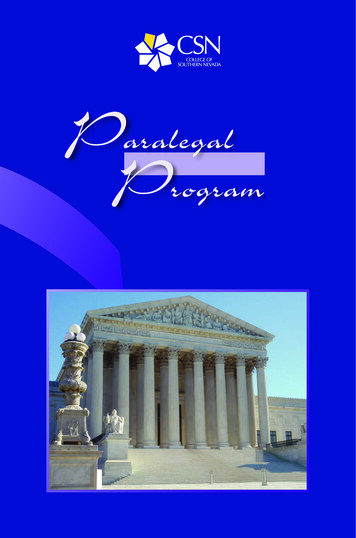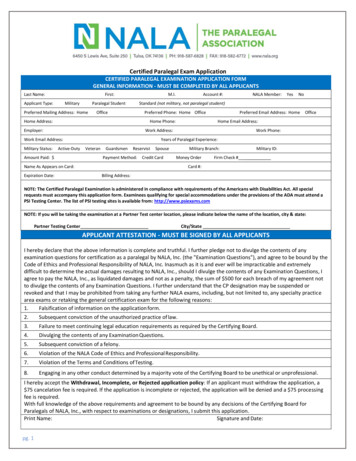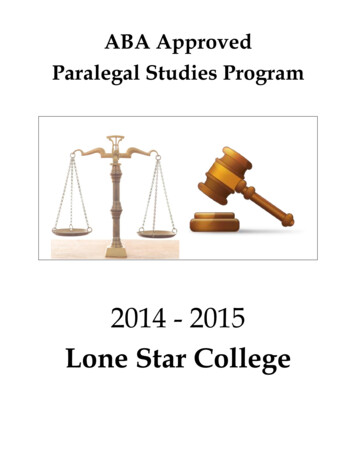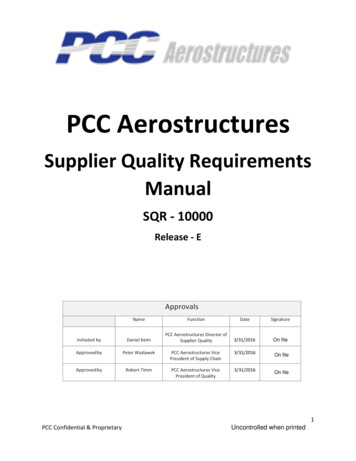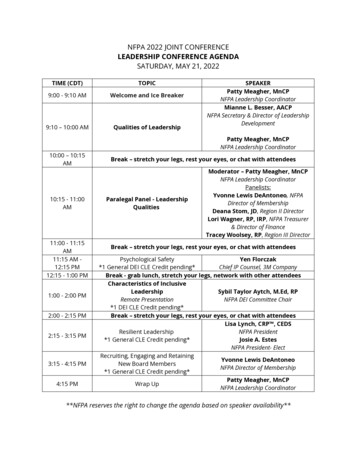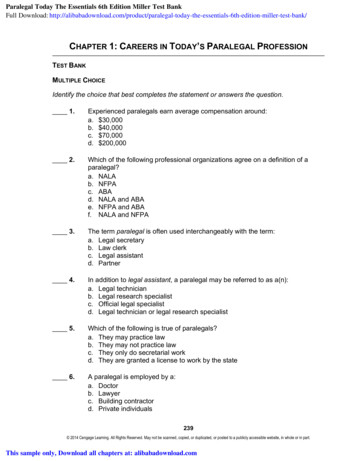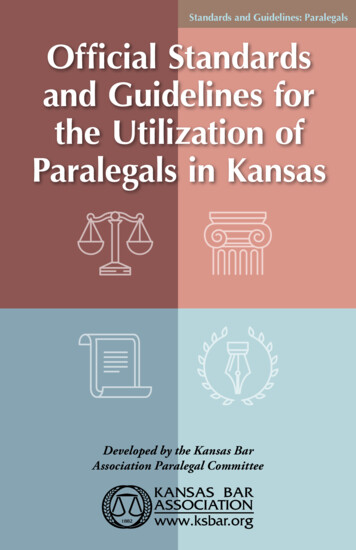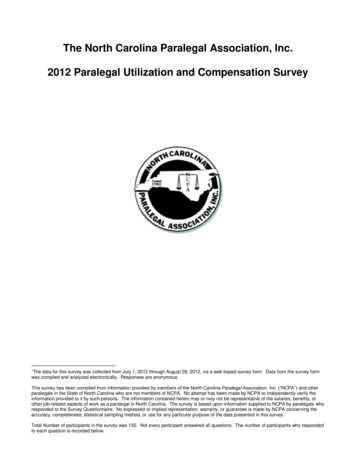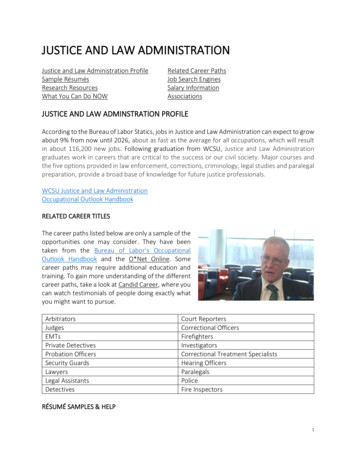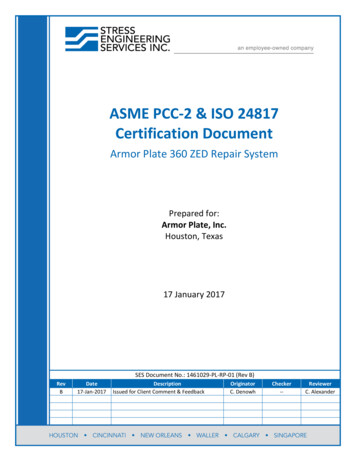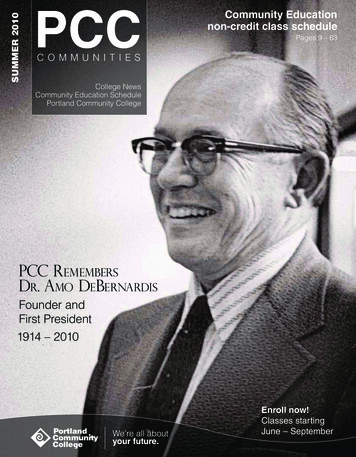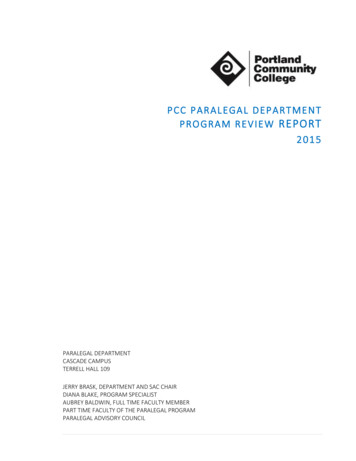
Transcription
P CC PAR A L EGA L D EP AR T ME NTPR O GR AM R EV I E W REPORT2 015PARALEGAL DEPARTMENTCASCADE CAMPUSTERRELL HALL 109JERRY BRASK, DEPARTMENT AND SAC CHAIRDIANA BLAKE, PROGRAM SPECIALISTAUBREY BALDWIN, FULL TIME FACULTY MEMBERPART TIME FACULTY OF THE PARALEGAL PROGRAMPARALEGAL ADVISORY COUNCIL
I.PROGRAM/DISCIPLINE REVIEW . 1II.OUTCOMES AND ASSESSMENT . 3III.OTHER CURRICULAR ISSUES . 6IV.STUDENTS AND THE COMMUNITY . 8V.FACULTY COMPOSITION AND QUALIFICATIONS . 10VI.FACILITIES AND SUPPORT . 11VII. SUCCESSFULLY PREPARING STUDENTS . 12VIII. RECOMMENDATIONS . 15EXHIBITSEXHIBIT 1 – 2013-2014 GRADUATE SURVEY . 1EXHIBIT 2 – GRADUATE STATISTICS. 8EXHIBIT 3 – STUDENT STATISTICS. 11EXHIBIT 4 – FACULTY COMPOSITION . 12EXHIBIT 5 – FULL TIME FACUTY AND STAFF . 13EXHIBIT 6 – FACULTY MEETING MINUTES. 14EXHIBIT 7 – PART TIME FACUTY . 28EXHIBIT 8 – PARALEGAL ADVISORY COUNCIL . 33EXHIBIT 9 –PARALEGAL ADVISORY COUNCIL MEETING MINUTES . 36EXHIBIT 10 – PARALEGAL DEPARTMENT FOCUS AWARDS . 44EXHIBIT 11 – ALTERNATIVE CAREER RESOURCES . 45EXHIBIT 12 – DEGREES AND CERTIFICATES BY MAJOR. 56EXHIBIT 13 – PCC CORE OUTCOME MATRIX . 61EXHIBIT 14 – MAPPING MATRIX . 62
I.PROGRAM/DISCIPLINE REVIEWA. EDUCATIONAL GOALS AND OBJECTIVES.Paralegal Department Outcomes are as follows:AAS: Paralegal Apply analytic, critical thinking and research skills to fact situations within a legalcontext Demonstrate professional skills necessary to a paralegal career, including oral andwritten communication and technology skills. Adhere to professional and ethical standards appropriate to the legal profession Use effective personal, interpersonal, time and project management skills required inthe legal profession Demonstrate breadth of knowledge across several disciplines in humanities, socialscience, mathematics and science 10.2010One-Year Certificate: Paralegal Apply analytic, critical thinking and research skills to fact situations within a legalcontext. Demonstrate professional skills necessary to a paralegal career, including oral andwritten communication and technology skills. Adhere to professional and ethical standards appropriate to the legal profession. Use effective personal, interpersonal, time and project management skills required inthe legal profession.These outcomes are consistent with outcomes of similar ABA Approved institutionsnationwide. They have not been changed since the last review. No changes arepresently anticipated.B. CHANGES SINCE LAST REVIEWABA. ABA Interim Report was filed in February, 2013, as part of the Program’s on goingresponsibilities to maintain ABA Approval. Other record keeping activities are on-goingand continue. This activity includes surveying all graduates within 6 months ofgraduation to determine employment status and to obtain feedback. Annual reportsare generated and attached as exhibits. Student surveys and career/employer surveysare conducted periodically.Staffing. Two full time permanent staff positions were added to the program. ParalegalProgram Specialist, Diana Blake began in January, 2013. She assists in advising students,supervision of work study students, maintaining ABA required records, and various otherday to day tasks of running the Department under the supervision of the DepartmentChair. The second position is a permanent full time faculty position filled by AubreyBaldwin, effective September, 2014. Traci Simmons, Perkins advisor, new since the lastreview, is also part of the Paralegal Department team. (Exhibit 5).Portfolio Assessment. The program initiated a portfolio requirement for students in thecapstone Applied Legal Research and Drafting course, PL 204, which has becomeintegral to the assessment process. See below under Mapping Matrix a more thoroughdiscussion of Portfolio.Paralegal Department Graduation Ceremony. During the Spring Term, 2014, theDepartment held its first graduation ceremony. It was held in the afternoon on thesame day as the PCC wide ceremony, allowing time for students to attend bothPCC Paralegal Program Review Report – 20151 Page
ceremonies. Over 100 students, family and friends attended, along with part timefaculty and Advisory Council members present. The ceremony was successful, and weplan to continue in 2015 and subsequent years.Litigation Courses. Since the last review, a focus group consisting of department staff,part time faculty and the advisory council met to consider what types of litigationcourses were needed by the program. The program had one course, Litigation, PL 105.As a result of these meetings, 2 courses were developed and added to the curriculum:Advanced Litigation, PL 205 and E-Discovery, PL 230. This strengthened the program’slitigation skills offerings.Technology Focus Awards. To encourage students to develop stronger technology skills,the department faculty, with Advisory Council support and input, developed two focusawards. Any student successfully completing the designated courses is entitled to one orboth of these non-transcripted department sponsored awards. Last year 11 awardswere issued at the department’s graduation ceremony. (Exhibit 10)Hybrid Courses. The Department offered specialized training for faculty whovolunteered to develop hybrid courses in 2011 and began offering hybrid courses(55/45% classroom/computer split). This model allows the program to offer 2 classes ina 3 hour time slot, instead of one and has been popular with a significant percentage ofstudents.Professional Paralegal Groups. There are 2 principle paralegal trade organizations inPortland, Oregon Paralegal Association and Pacific Northwest Paralegal Association.With the addition of department staff, the program has increased its presence andcollaboration with those groups.Program Growth. The program has grown to unprecedented size in terms of the numberof students, FTE and numbers of graduates. During 2013-14 the Department had thesecond largest number of CTE graduates, District-wide. (Exhibit 12)YearGraduatesHeadcount2013-14114 Total (92AAS, 22 Cert)579 AAS/32 Cert2012-1380 Total (70 AAS, 10 Cert)622 AAS/36 Cert2009-1053 Total (42 AAS, 11 Cert)377 Total2007-0843 Total (34 AAS, 9 Cert)292 Total2003-0430 Total (19 AAS, 11 Cert)242 TotalThe 2009 ABA site visit team reported the PCC Paralegal Program on a “strong” programproviding an “excellent” education. Graduate numbers doubled since 2010.The Paralegal Program is a strong CTE Program, in terms of strength of instruction,national approval, number of graduates and ability of graduates to find good jobs.Jobs and Careers. The program surveys its graduates within 6 months of graduation andpublishes annual results. (Exhibit 1) .Of those students responding to the surveyrequests, the program in 2013-2014 reported 65% and in 2012-13 reported 69% of itsgraduates employed in legal jobs, not counting those who went on to four year collegesor stayed in existing jobs and used paralegal training to enhance that job. The graduatenumbers have been running in the 60% range now for several years. (Exhibit 2)Prerequisites. In the ABA site visit report, the site visit team recommended consideringprerequisites for PL courses. The program has made PL 101, the Intro class for theprogram, a pre or co requisite for all Paralegal Department courses. PL 101 is importantPCC Paralegal Program Review Report – 20152 Page
to the program, as it establishes a high bar of expectations for students within theprogram, while providing basic fundamentals to help ensure success in the remainingcourses. PL 101 is challenging, but includes supports for success, including peer tutor,learning styles training and opportunity for a makeup midterm exam.Learning Styles. The program has begun incorporating learning styles instruction in thePL 101 course through coordination with the program’s Perkins Advisor, Traci Simmons.C. CHANGES MADE AS A RESULT OF THE LAST REVIEWStaffing. The addition of full time permanent staff members, Department specialist andfull time faculty, as discussed above, were made as a result of requests at the last reviewand administrative response which was generally supportive of those requests.TH 107. In the ABA site visit report from 2009, the site visit team recommended that theadjoining classroom to the department’s legal research center, TH 107, be made adesignated classroom for the department. The department has been provided exclusiveuse of the room effective the fall, 2014 term.II.OUTCOMES AND ASSESSMENTA. COURSE-LEVEL OUTCOMESThese outcomes are very comparable to outcomes of other Paralegal Programsnationally. The program focuses on teaching practical skills. The outcomes have notchanged since the last review. Presently, no changes to outcomes are planned.However, in the fast-paced environment of the law, it would not be surprising forchanges to be considered within the next 5 years.B. ADDRESSING COLLEGE CORE OUTCOMESCommunication. Communicate effectively by determining the purpose, audience andcontext of communication, and respond to feedback to improve clarity, coherence andeffectiveness in workplace, community and academic pursuits.The legal profession is a helping profession: focused on solving problems for clientsthrough careful and competent representation. Communication is essential to this goal,and paralegals are expected to communicate effectively with a variety of people – fromcourts to witnesses – using a broad range of techniques. Communication skills are oftencited among the top skills that legal employers are looking for in new-hires. For thesereasons, the Paralegal Program emphasizes communication skills throughout thecurriculum.The Paralegal Program curriculum introduces writing skills early and provides studentswith successive opportunities to practice writing throughout the course of study. Thefirst course, PL101, introduces students to legal writing through written summaries ofcourt opinions (case briefs). In PL102, students continue to develop writing skillsthrough case briefs and drafting documents to be filed with the courts (pleadings).PL201 and PL202, the legal research courses, focus on the fundamentals of analytic legalwriting. Students practice these skills in elective courses where writing projects aretypical methods of assessment. The final required course in the program – PL204 –gives students the opportunity to draft, and re-draft with faculty feedback – over adozen legal documents, and to develop a portfolio of written work from the program todemonstrate competence in legal writing.The Paralegal Program also emphasizes oral communication. With regard tointerpersonal communication, there are specialized courses in interviewing (PL107) andinvestigation (PL104). These courses develop a student’s ability to communicate face-to-PCC Paralegal Program Review Report – 20153 Page
face with a variety of people, and provide students with vital practice in listening tocomprehend significance. With regard to more formal oral communication, students areexpected to make oral presentations in several courses, starting in PL 101, including anoral presentation of their Portfolio in PL204.Community and Environmental Responsibility. Apply scientific, cultural and politicalperspectives to natural and social systems and use an understanding of social changeand social action to address the consequences of local and global human activity.Because the legal profession is one of the foundational institutions in our society,education to work in the legal system is inherently and explicitly tied-up-with concernsabout how society addresses the consequences of human activity. The substantivecourses offered in the Paralegal Program allow students to develop solid comprehensionof how almost every facet of life is impacted by the legal system. More specifically,students are required to learn the ethical rules under which lawyers and judges operatein PL103.Critical Thinking and Problem Solving. Identify and investigate problems, evaluateinformation and its sources, and use appropriate methods of reasoning to developcreative and practical solutions to personal, professional and community issues.At its core, the legal profession is concerned with solving client’s problems. To do so,legal professionals must think critically and analytically about client problems and theirpotential solutions. For this reason, all courses in the Paralegal curriculum requirestudents to apply analytic and critical thinking skills to fact situations within a legalcontext. Moreover, the curriculum emphasizes legal research in two core courses(PL201 and PL202), along with fact investigation in the interviewing (PL107) andinvestigation (104) courses.Cultural Awareness. Use an understanding of the variations in human culture,perspectives and forms of expression to constructively address issues that arise out ofcultural differences in the workplace and community.Several courses in the Paralegal Program include content dealing with culturaldifferences. For example, in the legal ethics course (PL103), students are expected tothink critically about their own cultural perspectives, values and assumptions, how thosemay impact their interactions with others, and modify their own biased based behavior,practices and language to effectively interact with people with other culturalperspectives, values and assumptions. In the Employment Law course (PL 216), studentspresent an international project on employment law in a selected nation, including adiscussion of how the culture and historic events have shaped that nation’s employmentlaws.Professional Competence. Demonstrate and apply the knowledge, skills and attitudesnecessary to enter and succeed in a defined profession or advanced academic program.The Paralegal Program emphasizes practical skill building in many of its courses, and hasa robust co-op education component where students gain on-the-job training andexperience for credit. By the end of the program, students have been introduced to andpracticed the fundamental professional skills of the paralegal. Students produceprofessional work products using appropriate technologies.Self-Reflection. Assess, examine and reflect on one's own academic skill, professionalcompetence and personal beliefs and how these impact others.The Paralegal Program provides tools for students to better understand themselves andhow they relate to the world. Beginning in PL101, students reflect on the skills requiredPCC Paralegal Program Review Report – 20154 Page
to be successful in the profession and how they can utilize existing skills and developothers. Other courses continue this process.In the capstone course (PL204), students draft and refine a reflection paper thatappraises the student’s skills and competencies in each of the Paralegal Programoutcome areas.PCC Core Outcome Matrix. (Exhibit 13)Mapping Matrix Attainment of program outcomes by individual students is addressedthrough a portfolio review program implemented in the Program’s capstone course,PL204. (Exhibit 14)C. DEGREE AND CERTIFICATE OUTCOMESParalegal Program Outcome 1: Apply analytic, critical thinking and research skills tofact situations within a legal context.PCC Core Outcomes: Professional Competence – Critical Thinking – CommunicationAssessment: The outcome is assessed via student Portfolio Review in PL204, whichserves as the Program’s TSA.Paralegal Program Outcome 2: Demonstrate professional skills necessary to a paralegalcareer, including oral and written communication and technology skills.PCC Core Outcomes: Professional Competence – Critical Thinking – CommunicationAssessment: The outcome is assessed via student Portfolio Review in PL204, whichserves as the Program’s TSA.Paralegal Program Outcome 3: Adhere to professional and ethical standardsappropriate to the legal profession.PCC Core Outcomes: Professional Competence – Community Responsibility – SelfReflection – Cultural AwarenessAssessment: The outcome is assessed via student Portfolio Review in PL204, whichserves as the Program’s TSA.Paralegal Program Outcome 4: Use effective personal, interpersonal, time and projectmanagement skills required in the legal profession.PCC Core Outcomes: Professional competence – Self Reflection – CulturalAwareness – CommunicationAssessment: The outcome is assessed via student Portfolio Review in PL204, whichserves as the Program’s ts.htmlDesign and Processes. The Paralegal Program believes a portfolio is the most effectivemethod to measure the program's success in outcome achievement. Our program hasselected the Portfolio in lieu of other methods, such as program-wide exams. This wasdone through consultation with faculty, the Advisory Council and other college staff,including Gabe Hunter-Bernstein, who has experience in this process.The Portfolio Project is a required component of PL 204. The Project has three purposes:1) to evaluate student performance and achievement of identified outcomes; 2) toevaluate the department's success in training students at the completion of eachstudent’s degree/certificate, and 3) to enable students in identifying documents theymight use as sample work product for potential employers. The Portfolio includes aPCC Paralegal Program Review Report – 20155 Page
reflection paper and a selection of documents and other artifacts that demonstrate thestudent’s learning of program outcomes, and the student’s resume and sample coverletter. Students present their portfolios to panels of faculty, Paralegal AdvisoryCommittee members, and program alumni on the last day of the PL204 course. Studentsgive a three-to-five minute presentation, followed by ten to fifteen minutes of discussionwith the panel.Results of the Assessments. Student success in demonstrating competence in outcomeareas through the portfolio has been high. In 2013-2014 the sample size was 113students, with over 98% demonstrating outcome competence through their portfolioproject. These statistics are reported annually to the college and State of Oregon.Examples of Change. The Paralegal Program has made a number of changes to theTechnology Skills curriculum as a result of assessments of the technology skills outcome.In response to the 2011-2012 assessment and results of meetings of a litigation focusgroup, comprised of the Department Chair, Advisory Council members, and part-timefaculty assessing litigation skills, additional courses were permanently added to theprogram in technology skills, including an Advanced Litigation course and an ElectronicDiscovery course. A basic Microsoft Office training course, CAS 133 was made aprerequisite to Legal Software, PL 130, a required course. Also during the 2012-2013academic year, in response to assessment in 2011-2012, the Paralegal Departmentdeveloped two Focus Awards in Technology - the Paralegal Department Technology FocusAward, and the "Paralegal Program Law Office Skills Specialist." In 2013-2014, the firsttime students could receive the awards, 11 of 110 graduating students received one orboth of the Focus Awards. A statement of requirements to receive the Awards isattached. (Exhibit 10). The 2012-2013 learning assessment revealed that students hadsome difficulty in demonstrating proficiency in technology using the documents in thePortfolios. To attempt to address this difficulty, the Portfolio project was amended torequire that students specifically demonstrate competence in the most common officesoftware programs (Word, Excel, PowerPoint, and Access) in 2013-2014.The Paralegal Program has also made changes to the Oral Communication portion of thePortfolio Review process to improve the efficacy of assessing oral communication skills.The Paralegal Department consulted with faculty and the Paralegal Advisory Councilregarding oral communication. Consistent with feedback from these groups, thedepartment will be phasing into the Portfolio process during 2014-2015 a three-to-fiveminute student oral presentation of the Portfolio.III. OTHER CURRICULAR ISSUESA. DISTANCE LEARNING.Several Paralegal faculty participated in program-sponsored training during 2010-2011 ondeveloping courses for hybrid offerings that would be in compliance with ABA standards.Some program faculty obtained college D2L training. Several part time faculty have offeredHybrid courses using D2L. The courses were well attended and appreciated by students,allowing 2 courses to be offered in a 3 ½ hour time block. We are hoping to attract and trainother faculty to continue offering this type of course.Our experience with the Hybrid indicates that faculty may be best prepared for D2L if theyuse the platform once in a regular classroom setting to increase their familiarity with theplatform, before teaching a Hybrid course. By providing students with an introduction to D2Lin the classroom portion of the Hybrid, students did not encounter significant difficulties.Faculty are able to develop on line activities which are appropriate for development ofPCC Paralegal Program Review Report – 20156 Page
practical skills. Classroom teaching is very popular with students in the program. Hybridcourses allow classroom teaching to continue, while providing some distance learningopportunities.B. EDUCATIONAL INITIATIVESObtaining ABA Approval in 2010 enhanced the value of the degree/certificate for studentsgraduating from the program by increasing the stature of the program. This initiativeincreased opportunities for all students. Individual faculty have added Internationalizationto their curriculum, for example in Employment Law (PL 216). Volunteer opportunities inservice organizations are available, announced and available to students on an on-going basisin the program. For example, students regularly volunteer for the Community Alliance forTenants hotline, SOAR Immigration Legal Services events, and participate in the Oregon TrialLawyers mock trials as jurors and witnesses. The program’s Paralegal Club has for the past 4years offered an annual Career Day event for a half day on Saturday morning in January.Legal professionals speak in large and small group break-out sessions to provide studentswith ideas to assist them in career development. Each year 60-100 students haveparticipated in this very popular event.Curricular changes were not necessary to provide these opportunities. As a CTE program,students are motivated to participate in such volunteer events because they are motivatedprofessionally.Internships, while not required, are a strong component of the program. Over the past 4years, the number of internships has been: 2010-2011: 63; 2011-2012: 87; 2012-2013: 88;2013-2014: 82.The Department supported development of Alternative Math courses based upon practicalskills over the past 5 years and supports the offering of Math 58 as an AAS degree alternativeto Math 65.C. DUAL CREDITThe program does not offer dual credit Paralegal Program courses.D. WORK WITH AREA HIGH SCHOOLSPresently, it does not appear that attempts to develop dual credit Paralegal Courseswould be productive. The program may explore ways to work with area high schools toencourage development of writing and analytic skills, and perhaps encouragedevelopment of a Business Law course, all good preparation for entry into the ParalegalProgram. We encourage dual credit Students to start with general education courses andcomputer skill electives to prepare for entry into the Paralegal Program.E. COURSE EVALUATIONSThe Paralegal Program's practice was to use hard copy course evaluations in every class,every term since 2005. These were available to the Dean and Department Chair and providedhelpful, useful feedback for individual faculty members and the program. Participation wasapproximately 95% of students, as the evaluations were done in the classroom and tabulatedby Division staff. The college's transition to on-line evaluations reduced participation to lessthan 30% of students in almost all classes, which limited the Department’s access to usefulinformation from students, The College's change of policy improved student participationduring the Fall term, 2014. The department has submitted department questions forstudents. With the improved participation, the usefulness of the on-line evaluations nowapproximates the value that existed before the on-line evaluations commenced.PCC Paralegal Program Review Report – 20157 Page
F. OTHER CURRICULUM CHANGES.Three new courses have been offered. As discussed above, PL 205-Advanced Litigation andPL 230-E-Discovery have been added to the curriculum with the program’s Litigation Course,PL 105 as a prerequisite. This resulted from discussions among faculty and advisory councilmembers. The courses have improved the program’s ability to enhance litigation skills ofstudents in the program. Another course added is Environmental Law, PL 240.The program has also made changes through the Curriculum Committee to establish allcourses in the program with a pre or co requisite of PL 101. This ensures that PL 101 is takenas a student enters the program and strengthens program development.IV. STUDENTS AND THE COMMUNITYA. STUDENT DEMOGRAPHICSThe program is based at Cascade, but also offers classes at the Climb Center. Students residethroughout the Portland metropolitan area. An estimated 25% of students in the programwork in downtown Portland. Offering classes at Cascade and the Climb Center makes accessto courses for this group of students accessible. While the program has experimented in thepast with offering classes at Rock Creek and Sylvania, experience indicates that offeringclasses at these campuses reduces course enrollment and requires offering more classes tobalance the needs of students. Students are relatively satisfied with the location of coursesat Cascade and Climb Center, and it is hoped that the continued offering of Hybrid courseswill help as a distance modality.The program has almost 25% of its students identified as racial ethnic minorities on 20132014. Age is widely distributed across all age groups at rates which exceed the collegeaverages for 40-60 year old age groups. Gender breakdown is 75% female, 25% male.Student diversity has enriched the program. (Exhibit 3).B. CHANGES IN INSTRUCTION DUE TO STUDENT DEMOGRAPHICSStudent demographics have been relatively stable. There have not been changes ininstruction due to student demographics.C. CURRENT/PROJECTED DEMAND AND ENROLLMENT PATTERNSEnrollment in the required entry course: PL 101-Introduction to Law Course, is steady. Overthe past 2 years, the program has been offering 2 program entry courses (PL 101) per termnot including summer. This results in approximately 150 new students per year. Theprogram projects that this demand will continue and plans to add one new section of theentry level course during the summer term, 2015. This will maintain enrollment in ParalegalDepartment core classes and electives at approximately current levels.The department offered 3 sections of PL 101 per term for approximately 2 years (2011-2013)(225 new students per year). Enrollment jumped and the program experienced some strain.While there is resulting decrease in FTE over the past year, the reduction in enrollment to 2sections of PL 101 was planned and intentional. The department believes the currentenrollment plan is best in keeping with available resources.D. STRATEGIES TO FACILITATE ACCESS AND DIVERSITYThe program strongly supports access and diversity for students entering the program.While the Introductory course (PL 101) and curriculum in the Paralegal Program arePCC Paralegal Program Review Report – 20158 Page
challenging, the program supports program success by offering tutoring for the introductorycourse. Peer tutoring from existing students and graduates is available to help studentstransition into the program. Individualized advising from the Perkins advisor, ProgramSpecialist and Department Chair allow the program to reach out and support student access.Learning Styles Training at Cascade was provided in PL 101 from 2005-2010. Campus fundingended in 2010. Learning Styles has been renewed as part of PL 101 in 2014-2015 throughcollaboration with the Program’s Perkins Adviser, Traci Simmons.The program sponsored connections with diversity during the Fall, 2014 when it cosponsored a campus wide presentation by a transgender paralegal student regarding herpersonal and legal journey. The program has participated in college fair events to publicizePCC programs. The program has prioritized efforts to hire diverse faculty and worked withthe Office of Equity and Inclusion, which resulted in hiring of a full time temporary statusins
The Paralegal Program is a strong CTE Program, in terms of strength of instruction, national approval, number of graduates and ability of graduates to find good jobs. Jobs and Careers. The program surveys its graduates within 6 months of graduation and publishes annual results. (Exhibit 1) .Of those students responding to the survey
